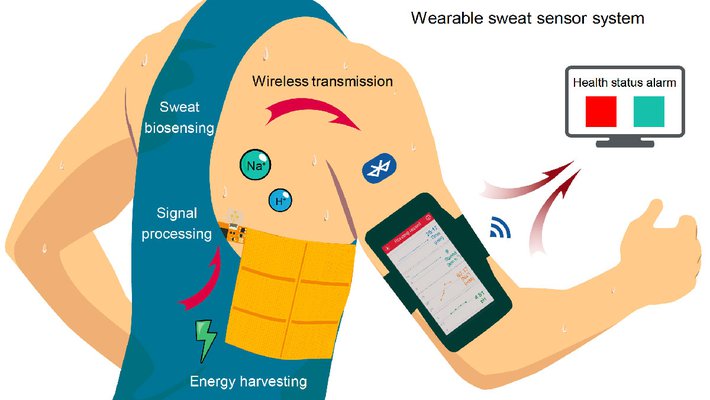创新背景
廉价的可穿戴传感器可以监测心率和体温,以及血糖和代谢副产物的水平,研究人员和卫生专业人员能够通过它以前所未有的方式监测人类健康。但像所有电子设备一样,这些可穿戴传感器需要电源。电池是一种选择,但不一定是理想的,因为它们可能体积庞大,重量大,电量易耗尽。
创新过程
研究人员开发了一种为无线可穿戴传感器供电的新方法——纳米发电机,可收集一个人在四处走动时产生的动能。
这种能量收集是用附着在人的皮肤上的材料(特氟龙,铜和聚酰亚胺)的薄三明治完成的。当人移动时,这些材料片与由铜和聚酰亚胺制成的滑动层摩擦,并产生少量的电力,这种效应被称为摩擦电。

新型摩擦电发电机,也称为纳米发电机,有一个固定在躯干上的定子,以及一个连接到手臂内部的滑块。在人体运动过程中,滑块在定子上滑动,同时产生电流,
创新点在于如何制造纳米发电机。

研究人员使用市售的柔性电路板,这种材料价格便宜,并且耐用,机械坚固耐用,可以长时间使用。纳米发电机不会产生大量的电力。事实上,人们需要一个表面积为100平方米的设备来为40瓦的灯泡供电。然而,可穿戴传感器具有低功耗要求,并且系统将产生的电力存储在电容器中,直到有足够的电荷从传感器获取读数并通过蓝牙将数据无线发送到手机。一个人移动得越多,传感器收集数据的频率就越高。然而,即使这个人相当久坐不动,传感器最终也会积累足够的功率来运行。
创新关键点
新型摩擦电发电机,也称为纳米发电机,有一个固定在躯干上的定子,以及一个连接到手臂内部的滑块。在人体运动过程中,滑块在定子上滑动,同时产生电流,
创新价值
该设备有希望通过使用通过多种方法产生的功率来运行可穿戴传感器。例如,可穿戴设备可能使用汗水产生的电力、摩擦发电机和小型可穿戴太阳能电池板。
Innovative development of "nanogenerators" to provide human power for wearable sensors
Researchers have developed a new way to power wireless wearable sensors -- a nanogenerator that captures the kinetic energy a person generates as they move around.
This energy harvesting is done using thin sandwiches of materials (teflon, copper and polyimide) attached to the human skin. As the person moves, these sheets of material rub against a sliding layer made of copper and polyimide and generate a small amount of electricity, an effect known as triboelectric.
The new triboelectric generator, also known as a nanogenerator, has a stator fixed to the torso and a slider attached to the inside of the arm. During human motion, the slider slides across the stator and generates an electric current.
The innovation lies in how to make nanogenerators.The researchers used commercially available flexible circuit boards, which are inexpensive and durable, mechanically robust and can be used for a long time.
Nanogenerators don't produce a lot of power. In fact, one would need a device with a surface area of 100 square meters to power a 40-watt light bulb. However, wearable sensors have low power requirements, and the system stores the power generated in capacitors until there is enough charge to take readings from the sensors and send the data wirelessly to the phone via Bluetooth. The more a person moves, the more frequently the sensors collect data. However, even if the person is fairly sedentary, the sensor will eventually accumulate enough power to operate.
智能推荐
传感器技术创新思维 | 创新利用乙烯切割机制造可穿戴传感器
2022-11-09加州大学伯克利分校的工程师开发了一种制造可穿戴传感器的新技术,使医学研究人员能够以比现有方法更快的速度和更低的成本对新设计进行原型测试。
涉及学科涉及领域研究方向传感器技术创新思维 | 新型可穿戴传感器可检测人体汗液中的更多化合物
2022-10-11来自加州理工学院的一组研究人员推出了一种新的可穿戴传感器,可以在人体汗液中检测出许多常见营养素和生物化合物的微小水平,这些营养素和生物化合物可以作为人类健康的指标。
涉及学科涉及领域研究方向激光技术创新思维 | 创新利用二氧化硅纤维开发“自冷却激光器”
2022-10-24斯坦福大学的研究人员开发了第一根由二氧化硅制成的自冷却光纤,用于激光应用,并迅速将其开发成激光放大器。
涉及学科涉及领域研究方向无线电物理创新思维 | 创新利用磁力“无线传输”电能可实现无线充电
2022-10-24研究人员开发了一种新方法:利用磁力无线传输电能,为电动汽车、机器人甚至无人机充电。
涉及学科涉及领域研究方向